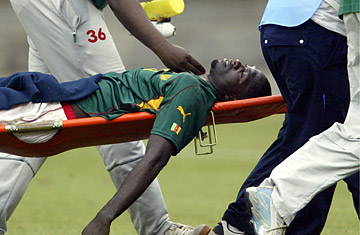
Marc Vivien Foe of Cameroon is taken off the field during a semifinal Confederations Cup match on June 26, 2003. He died that night, with an autopsy later revealing hypertrophic cardiomyopathy
For most people, regular exercise is associated with cardiovascular health. But doctors have long noted a troubling tendency among the ultra-fit: an athlete has a greater chance than the average person of suddenly dropping dead. As physicians and sporting organizations learn more about the condition known as sudden cardiac death (SCD), their research has opened an emotive and evolving debate about what can be done to protect athletes — and how much money should be spent trying to prevent what is still a rare but devastating occurrence.
SCD — an abrupt and fatal loss of heart function — is estimated to kill anywhere from 1 in 15,000 to 1 in 50,000 athletes. According to the International Olympic Committee, that rate is about three times higher than in the normal population. The condition usually gains public attention only after the death of an élite sportsman, like when Reggie Lewis of the Boston Celtics collapsed and died during basketball practice in 1993. However, all participants in regular athletic training — from recreational joggers to high school soccer players — are at increased risk. Almost all cases of SCD occur in athletes with hereditary or congenital cardiovascular diseases like hypertrophic cardiomyopathy, a thickening of the heart. In 80% of cases, these diseases are asymptomatic and death occurs with little or no warning, almost always during or shortly after sport. Screening programs can identify heart abnormalities, but physicians disagree on which programs should be used and on whom and how often.
In an article for the Sept. 7 edition of the British Journal of Sports Medicine that was sponsored by the IOC, cardiologists from Britain and the Netherlands reviewed existing studies on SCD and came to the conclusion that all athletes under the age of 35 should be routinely tested for heart abnormalities using a 12-lead electrocardiogram (ECG). That conclusion is in line with a document published by the IOC in March that encourages national Olympic bodies to test all athletes with an ECG before they enter into competition. Some professional sports leagues, such as the NFL in the U.S. and the Premier League in the U.K., already require their athletes to undergo ECG screenings.
But many sports cardiologists think that's a bad idea. The American Heart Association (AHA), while agreeing with the need for a screening program, believes that universal ECG tests are not cost-effective and are also likely to result in unacceptably high rates of false-positive results. It recommends that athletes instead be screened through a health questionnaire and physical examination, with an ECG used only as a secondary investigation. "Our current position on screening young people before athletic competition calls for a thorough patient and family medical history and a physical exam as the first line of screening, and the advice of the individual's health-care provider to decide on further testing," Dr. Clyde Yancy, president of the AHA, told TIME in a prepared statement.
Dr. Sanjay Sharma disagrees. A cardiologist at King's College Hospital in London and one of the authors of the British Journal of Sports Medicine's study, Sharma believes that results from Italy — which instituted a nationwide ECG screening program for athletes in 1983 — provides enough evidence of the effectiveness of an ECG to override the AHA's concerns. Analyzing data from 42,000 athletes in the northeastern Veneto region of the country from 1979 to 2004, Italian researchers found that ECG screening resulted in an almost 90% drop in sudden cardiac deaths. Incidence of SCD among the unscreened nonathletic population did not change significantly during that time.
Though simple to perform, each ECG test usually costs about $500, says Sharma. The test returns accurate results for 98% of people with structural heart defects like hypertrophic cardiomyopathy. However, the Italian researchers found that 7% of tests returned a false-positive result, requiring athletes to undergo more expensive investigations — and deal with the anxiety of wondering whether there was something wrong with their hearts. What's more, some cardiologists believe that physical examinations can be equally effective in uncovering heart defects in athletes. A non-ECG screening of high school and college athletes in the U.S. from 1983 to 1993 resulted in an annual death rate as low as in the Italian ECG screening program — although some cardiologists have disputed the methodology of the study that examined the U.S. screening program.
But Sharma says he became convinced of the need for ECG tests through his work as head of the screening program for British athletes, for which he screens players in soccer's Premier League and Britain's Lawn Tennis Association as well as amateur athletes on behalf of a British cardiac-risk charity. He hopes to publish the results of his work in the coming years. "It's very difficult to justify cost-effectiveness of ECG screening without using an emotive argument," he says. "We've screened 8,000 British athletes and have picked up a potentially fatal condition in 0.3% [of them]. For every 300 athletes we screen, we find one with a condition that could kill that individual. How can you put a price on a vibrant 16-year-old dying?"
